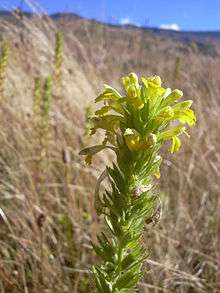Parentucellia viscosa
| Parentucellia viscosa | |
|---|---|
 | |
| Scientific classification | |
| Kingdom: | Plantae |
| (unranked): | Angiosperms |
| (unranked): | Eudicots |
| (unranked): | Asterids |
| Order: | Lamiales |
| Family: | Orobanchaceae |
| Genus: | Parentucellia |
| Species: | P. viscosa |
| Binomial name | |
| Parentucellia viscosa (L.) Caruel | |
Parentucellia viscosa is a species of flowering plant in the broomrape family known by the common names yellow bartsia[1] and yellow glandweed.[2] It is native to Europe, but it can be found on other continents, including Australia and North America, as an introduced species. This is an erect annual herb producing a stiff, slender stem coated in hairs and sticky glands. It reaches a maximum height of 50 to 70 centimeters. The hairy leaves are lance-shaped to oval and are lined with several teeth. The inflorescence is a raceme of flowers at the end of the stem. The flower is tubular, the calyx of sepals extending along most of the length of the corolla, which may exceed 2 centimeters long. The lobed, lipped corolla is yellow in color and glandular and sticky in texture.
References
- ↑ "BSBI List 2007". Botanical Society of Britain and Ireland. Archived from the original (xls) on 2015-02-25. Retrieved 2014-10-17.
- ↑ "Parentucellia viscosa". Natural Resources Conservation Service PLANTS Database. USDA. Retrieved 30 January 2016.
External links
| Wikimedia Commons has media related to Parentucellia viscosa. |